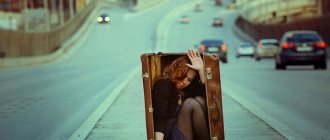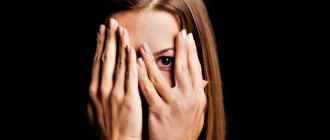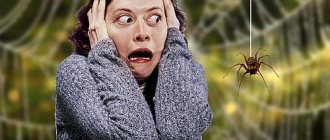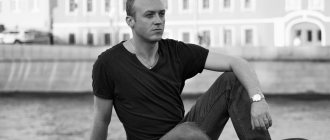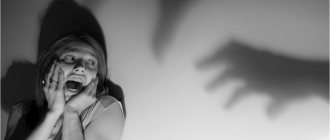People are born with some innate phobias, such as the fear of falling. We acquire some phobias throughout our lives. Everyone has heard about fear of heights, fear of water, fear of public speaking and other similar fears. However, there are unusual phobias in the world that many people do not know about. Did you know that there is a fear of the color yellow called “xanthophobia” or a fear of beards and bearded people called “pogonophobia”?
A phobia is a strongly expressed, obsessive fear that irreversibly worsens in certain situations and cannot be fully explained logically. As a result of the development of a phobia, a person begins to fear and, accordingly, avoid certain objects, activities or situations.
VseZnaesh.ru has collected 20 of the most unusual phobias that people suffer from.
Chronophobia - fear of time or the movement of time
Chronophobia is a specific psychological phobia that is a fear of time, or the passage of time. Chronophobes feel that the present moment may soon become the past, and it passes very quickly. They may feel like they haven't done enough in life and time flies.
The phobia, which can be genetic, can be caused by depression. Fear is mainly experienced by older people and people who are in one place or trapped without the opportunity to go outside (for example, in prison). A phobia can occur in people who are in a state of heightened anxiety.
1. Xanthophobia – fear of the color yellow
People with xanthophobia may fear any yellow objects, including the sun, daffodils, and yellow paint. In its most aggressive form, xanthophobia can manifest itself as a fear of even the word “yellow.”
2. Turophobia - fear of cheese
People suffering from turophobia tend to associate cheese with some kind of traumatic memory. And it doesn’t matter what kind of cheese it is - mozzarella or cheddar - turophobes often run away headlong at the sight of even the smallest piece of cheese. Some are afraid of a certain type of cheese, others are afraid of cheese in general.
3. Somniphobia – fear of falling asleep
Somniphobia is expressed in an irrational and extremely strong fear of falling asleep. Somniphobes are afraid to fall asleep because they associate sleep with death. This phobia may also arise from the fear of losing control of oneself while sleeping or from frequent nightmares. Somniphobes may also be afraid of wasting a lot of time while sleeping.
4. Coulrophobia – fear of clowns
Nowadays, courophobia is a fairly common phenomenon. According to many studies, it mainly affects children. The image of the “scary clown” often appears in popular culture - think, for example, of the Joker in comics and films about Batman. Even some famous people suffer from coulrophobia, including Johnny Depp and Daniel Radcliffe. Here's what Depp says about his fear of clowns: "Because of their painted faces, you can't tell what's on their mind - whether they're happy or if they're going to bite your face off."
5. Hylophobia - fear of trees
Hylophobia is an irrational fear of trees or forests. It often appears after a child watches a movie or hears a fairy tale in which the forest is scary and the trees are evil. Many chilophobes never manage to outgrow their fear with age, and any walk in the park causes them severe anxiety. Some of them experience unbearable anxiety just thinking about the forest.
6. Omphalophobia – fear of belly buttons
Omphalophobia is the fear of belly buttons. People suffering from this phobia are afraid of someone touching their belly button and are afraid of touching other people's belly buttons. This fear is often due to the fact that belly buttons are typically associated with the umbilical cord and the womb. Sometimes omphalophobes are afraid to look or even think about belly buttons.
7. Nomophobia – fear of being left without mobile communications
This fear of being left without mobile communications received its name five years ago, when scientists discovered this phobia. More than half of the UK population suffers from this phobia, according to new research. People are afraid to go into an area where there is no signal, they are afraid that their phone battery will run out - sometimes they become anxious if the phone is out of sight.
8. Ombrophobia – fear of rain
Ombrophobes are afraid of rain, which can lead to a serious panic attack. It is believed that a fear of rain can develop for several reasons, including because children are often told not to go outside in the rain, adding that they may get sick. Additionally, rain is often associated with depression.
9. Papaphobia – fear of the Pope
Fear of the Pope or the papal throne is a fairly rare occurrence. It is closely related to hierophobia (fear of clergy or religious objects). It is also associated with hagiophobia - an excessive and irrational fear or dislike of saints or sacred relics. This fear usually stems from dad-related trauma.
10. Uranophobia – fear of the sky
People suffering from uranophobia fear the sky and the afterlife. Such fear often arises among believers who are afraid of God's judgment.
11. Pogonophobia – fear of beards
The term pogonophobia has been used since the 1850s and refers to the fear of beards. Recently presenter Jeremy Paxman accused the BBC of pogonophobia after he was criticized for appearing on Newsnight with a beard.
12. Trypophobia - fear of holes
People with trypophobia are afraid of cluster holes, that is, objects with many small holes. So far, this type of fear has not been included in the official list of phobias, although, according to some reports, thousands of people suffer from it. Research has shown that people with trypophobia associate holes with danger. Trypophobes are afraid of objects such as honeycombs, sponges, or plants that have many small holes. Symptoms of trypophobia can include nausea, itching and even panic attacks.
13. Triskaidekaphobia – fear of the number 13
Many people believe in omens associated with the number 13, but not all of them suffer from triskaidekaphobia. This fear is closely related to the fear of Friday the 13th. People suffering from this phobia studiously avoid things and activities associated with the number 13.
InoSMI materials contain assessments exclusively of foreign media and do not reflect the position of the InoSMI editorial staff.
Erythrophobia - fear of blushing
Erythrophobia is a specific social phobia in which people are afraid of blushing because it tends to attract the attention of others. This begins a vicious cycle of anxiety and redness that gets worse over time. The underlying fear is social anxiety, not blushing. Cognitive behavioral therapy can help treat this phobia.
To understand erythrophobia, let's first understand why we blush. Blushing is an involuntary reaction that is triggered by our nervous system and is part of the fight or flight response. It is a complex, self-perpetuating phobia that can intensify as anxiety increases. Blushing is a response to several things, one of which is anxiety.
When we are anxious, the level of adrenaline in our body increases, which causes the blood vessels to dilate, resulting in increased blood flow. It also causes vasodilation (dilation of blood vessels) in the veins of our face, which causes redness.
Social phobia: how not to be afraid of other people
If some people are afraid to be alone, a certain category of the planet's population is afraid of people. The phobia is divided into many large blocks: many of them have touched each person at least once.
The most common fears among social phobes include:
- crowds;
- public speaking;
- to be ridiculed, rejected;
- going out;
- be condemned.
Most have learned to cope with the phobia, but for some inhabitants of the planet it becomes the worst nightmare that interferes with life. In severe cases, it leads to serious disorders: a person begins to avoid people, becomes a recluse, and begins to live in imaginary worlds. Social phobia can be successfully treated, the main thing is to start psychological classes. The mild form is easier to correct: leaving the comfort zone, communicating through strength, overcoming barriers will help isolate fears.
Chiclephobia - fear of chewing gum
Chiclephobia is a rare, specific fear of chewing gum that Oprah Winfrey has. She said it stems from her childhood memories of her grandmother hiding gum in the closet. People with chyclophobia cannot see someone else's chewing gum or look those who are chewing in the eyes.
Some people may vomit if they accidentally step on discarded gum or feel physically ill at the sight of chewing gum.
How to cope?
Most people who are susceptible to phobias and are aware of this are ready to be treated for them. In this case, it is possible to cope with the problem in 90%. The effectiveness of treatment directly depends on both the type of phobia and the person himself.
One of the methods is often characterized as “knocking out a wedge with a wedge,” i.e. when a person is exposed to his fear object.
Article on the topic
There is no more fear to be had. Psychologist about mass phobias, zaumi and the benefits of a crisis. Moreover, this interaction often happens for a long period of time, when he does not even have the opportunity to escape and defend himself. The purpose of this treatment option is the idea that until a person looks his fear in the eye, he will not be able to cope with it.
The other method is completely opposite. It is based on opposition. Here, on the contrary, a person is taught relaxation methods that will allow him, in moments of anxiety, to relax and stop being afraid. Thus, he moves away from his fear and calms down.
Naturally, all treatment requires contacting a professional specialist - a psychologist, and in some cases, a psychotherapist.
Venustrophobia - fear of beautiful women
Venustrophobia , also known as "caliginephobia" , is distinct from the fear of women (gynophobia). People who suffer from this phobia feel shortness of breath, sweating, nausea and other symptoms when they look at or are in close proximity to a beautiful woman.
Many people also experience panic attacks. Their phobia may cause them to keep their distance from people they consider beautiful. The reason for this fear is rooted in the unconscious state, where it is likely that an unfortunate event involving a beautiful woman may have occurred in the past. Different people exhibit different degrees of symptoms.
[CHOSEN FOR YOU] The Most Incredible Sewer Finds
Trypophobia
Translated from Greek, trypa means “hole.” Trypophobia is the fear of numerous groups of holes, bumps, and circles. People possessed by a phobia cannot calmly look at sponges, honeycombs, plants with spores, seeds, and in especially severe cases, even at coffee foam or their own skin covered with pores. Some people feel like there are nasty insects living in the holes, others feel discomfort at the thought that a black hole might suck them through the holes; in general, reactions range from simple hostility to panic. This strange fear is quite common. But despite the annually increasing number of people suffering from it, experts are in no hurry to officially recognize it as a phobia.
Gamophobia - fear of marriage
Many people experience the opposite of gamophobia, called anuptaphobia, which is the fear of being alone. Gamophobia , on the other hand, is the fear of marriage, relationships, or commitment. For example, a person suffering from this phobia may fall in love with a person, but his love may change to hatred when it comes to marriage. Phobias are associated with a number of personality disorders.
Fear of cowardice: boys should not be afraid
Surprisingly, one of the biggest and worst phobias of men is cowardice. From childhood, social attitudes instill in boys to be strong and courageous, not to cry and not to be afraid of anything.
This pressure on a subconscious level causes fear of not being able to cope with fear in a responsible situation and showing oneself as a coward. Especially if, due to his character or physical capabilities, a man is not inclined to show aggression, courage or leadership qualities. Often fear gives positive results: in order to prove his worth to himself, a man becomes more responsible, keeps the surrounding reality under control, and gives security to loved ones.
Phobophobia - fear of phobias
Having a fear of a phobia or phobias is closely associated with anxiety disorders. Phobophobia is specifically the fear of the sensations a person experiences when they are afraid or encounter a pre-existing phobia. A person may develop phobophobia in their unconscious state if they associate emotional stress or trauma with a phobia they may have experienced in the past.
They begin to fear their very fear. It can also lead to panic attacks, excessive sweating, hyperventilation, and anxiety.
Top 10 most terrible human phobias
- The fear of loneliness is the worst.
- Fear of death is one of the most terrible phobias.
- Social phobia is a fear people have.
- Fear of specific objects - each person has his own worst phobias.
- Fear of intimacy affects the inhabitants of the planet of all ages.
- Fear of madness is the fear of losing a sense of reality.
- Fear of germs and bacteria is a terrible disease of modern man.
- Fear of cowardice is a big phobia for men.
- Fear of poisoning is a phobia of the rich.
- Fear of old age - wrinkles and helplessness.
Xenophobia - fear of foreigners or strangers
It is common knowledge that Stephen Hawking was afraid of aliens. In 2012, he warned people that aliens could be roaming space and looking for planets to colonize and resources to plunder. Xenophobia can be the fear of any stranger or foreigner, or, as it was with Hawking, alien beings.
Webster's Dictionary defines "phobia" as "fear of the unfamiliar." This fear is present in many people, and some of the first instances of xenophobic sentiments were seen by the ancient Greeks. Xenophobia can also be a fear of loss of national, ethnic or racial identity.
Deipnophobia - fear of the dining room or conversations at dinner
According to the Anxiety and Depression Association of America, deipnophobia can be social anxiety or a specific phobia, depending on how it manifests. Deipnophobia can be a fear of talking at dinner and causes nausea or cramps after eating.
Some people may not like the conversations that happen during lunches and dinners together, but in some families it is common for the whole family to eat together and uncomfortable topics are brought up.
For people with this phobia, simply going to a restaurant can cause anxiety. This phobia is different from "sitophobia", which is a "fear of food or food in general" and is not specific to food. Deipnophobics may experience muscle tension, trembling, and sweating.
Coulrophobia
“Fear of clowns” is actually not such a rare phenomenon: both children and adults are susceptible to it. This phobia has become the theme of the plot of many horror films, where these characters often act as negative heroes, or even maniacal killers. Fear can also extend to people wearing makeup and masks. Psychologists explain the cause of the disease by saying that people are afraid of a person’s real face, hidden under a mask and an artificial smile - you never know for sure what exactly is on his mind.
Ephebiphobia - fear of teenagers or young people
First coined as "fear of teenagers" and now "ephebiphobia", is a term used to describe fear and aversion towards teenagers. Sociologist Ray Oldenburg links this fear to the generation gap in society.
This fear is not new; it was described by Machiavelli. This phobia is caused by external events and internal predispositions in a person’s life, combined with genetics, heredity, brain chemistry and life experiences. The assumption that teenagers are inherently dangerous, full of imbalanced hormones and uncontrollable, gives rise to a modern form of this very old phobia.
[CHOSEN FOR YOU] 20 Incredible Facts About the World You Never Knew
According to Kirk Astrot, a professor of family and consumer sciences at the University of Arizona in the US, Americans began to fear teenagers and their behavior in the late 1980s. Astrotus also coined the name for the phobia from the Greek word ephebe, which means "a teenage boy who is isolated from society at age 17 to learn to survive on his own and fight." The boy later returned to society and protected the city, but was feared at the same time.
Mageirocophobia
Behind this term lies an unusual fear of cooking, the name is derived from the Greek word mageirokos - “cooking specialist”. It is difficult for people suffering from this disorder to live in a family, especially if it is a woman who needs to cook homemade food every day. Lonely patients are forced to eat outside the home so as not to exhaust their bodies. In some cases, a person may additionally experience fear or discomfort when interacting with those who are good cooks.
Somniphobia - fear of sleep
This unusual phobia has been observed to be more common in children than in adults. Fear of sleep can be caused by fear of nightmares or other things that only happen to a person when he is sleeping or suddenly waking up.
Fear of sleep can also be caused by sleep paralysis, anxiety, waking up suddenly at night, or anything that makes a person afraid to go to bed. Somniphobia and insomnia are two different things . One is fear of sleep and the other is inability to sleep.
Selfiphobia
The fear of a bad selfie occupies a special place in the unusual list of phobias. A person who takes 100+ variations of the same photo until he gets the perfect result is not just a bore, he may be obsessed with selfiephobia. If this seems like complete nonsense to an ordinary person, then doctors recognize this illness as a serious mental disorder that can lead to dire consequences and even suicide attempts.
Siderophobia - fear of the stars in the sky
A very peculiar fear, siderophobes would not like to go out at night and cannot stand looking at the starry sky. They usually close the windows and draw the curtains at night to avoid catching a glimpse of the night sky. If they see stars, they may faint or exhibit several other symptoms of a phobia such as nausea, sweating, shortness of breath, panic attacks.
As with other phobias, siderophobia can develop due to a combination of several factors affecting the person. They may have experienced a traumatic event where they saw stars and began to associate stars with stress and fear.
Dromophobia – fear of crossing the street
The cause of such a phobia may be a road accident in which the patient lost a loved one, observing a road accident from the outside, or excessive fascination with the news. A person suffering from dromophobia tries in every possible way to avoid roads; it is difficult for him to cross them even at a pedestrian crossing, and it is difficult for him to walk on sidewalks. Any approach to roads is accompanied by attacks of panic. Patients with such phobias are more common in big cities, and much less common in rural areas.
Vestiphobia - fear of clothes
Westiphobes would not like to wear any clothes at all, or dress minimally. Wearing clothes, especially tight ones, can make a vestiphobe feel claustrophobic and uncomfortable. People who are allergic to various tissues may also develop vestophobia. Vestiphobia can also be a fear of certain clothes, such as trousers.
Insects, away!
Spiders often cause the development of so-called arachnophobia in humans. The nature of fear is simple: they have a specific appearance, in addition, many people extremely dislike their ability to suddenly appear out of nowhere - in just a minute they can appear right in front of your nose, descending on their web.
Article on the topic
It's scary to say! We get rid of the fear of speaking in public. Arachnophobia is also well cultivated by various horror films, where mystical significance is often attributed to spiders.
Arachibutyrophobia - fear of peanut butter sticking to the roof of the mouth
No matter how strange it may sound, there is such a phobia. Many people who love peanut butter may find it annoying that it sticks to the roof of their mouth. This can ruin their whole day. This particular fear is not a fear of peanut butter; It’s precisely the fear that it will stick. Even talking about it with someone or remembering how it got stuck in your mouth can be a nightmare for people suffering from this phobia.
Although the definition only talks about peanut butter, the same effect can be caused by bananas, Nutella, or other similar things that can also cause arachibutyrophobic anxiety .
Phronemophobia - fear of thinking
Fear comes over some people when they have to think. They may experience anxiety, panic attacks, trembling, dry mouth, etc. This is called phonemophobia and is closely related to another phobia called mnemophobia or “fear of memories .
[CHOSEN FOR YOU] 10 Most Dangerous Chemicals Known to Man
A phobia may be rooted in an unresolved emotional conflict that the person is afraid to repeat when he starts thinking, causing him to be afraid. A person’s childhood and upbringing can play a huge role in the occurrence of a phobia. This occurs as a result of the activation of a subconscious defense mechanism. The presence of thoughts can also cause a person to struggle with the phobia that he may do the unthinkable and create problems.
“Olfactory” problems – osmophobia
The second name for this specific disorder is olfactophobia.
This is a fear of smells and psychological hypersensitivity to them. Smells play an important role in people's lives. They are capable of causing euphoria, love (remember “Perfume” by Suskind), disgust, and expanding the perception of the world. They say that they give the strongest impetus to memories.
We can talk for a long time about how much smells mean to humans, but he received the sense of smell from nature, again for the purpose of survival. An unpleasant amber signaled the danger, for example, of some product intended for consumption. The pungent smell indicated the proximity of a predator, which also threatened our ancestors. So a certain aroma caused a gag reflex, fear, which was completely justified and life-saving.
But the osmophobe’s olfactory receptors do not respond correctly to any smell, and even his own seems disgusting to him. The individual’s nervous system becomes irritated: a feeling of fear “rolls over” him, he panics, although nothing threatens him.
This condition is usually experienced by people suffering from migraines (25% of all patients). Such an unbearable headache is precisely caused by unpleasant aromas or volatile substances.
Osmophobia can appear after tragic events that were accompanied by a certain smell. Age does not matter here: children, adolescents, and adults of both sexes are susceptible to this. In addition, individuals with hypersensitivity and melancholic people are susceptible to fear of smells.
The presence of olfactophobia may be indicated by positive answers to the following questions:
- Do odors emanating from people, objects, animals disgust you?
- Are there any scents you can't stand?
- Is the sense of smell often the cause of nausea and vomiting?
- Can smell give you a headache?
- Do you strive for loneliness due to irritability from people?
Five “yes” is a clear “bell” warning about the need to visit a doctor.
Ligyrophobia and other fears of sounds
Ligyrophobia is the fear of loud or sharp sounds. Its manifestations can be seen not only in the presence of such noise, but also in anticipation of it. The first name of the phobia comes from the Greek word “ligir” - sharp, which can be said about an unexpected high-pitched sound.
All the people flinch when they hear the loud, piercing sound and turn in the direction it came from. This is a completely normal reaction of the body to the unexpected, and the anxiety that arises instantly disappears. But this is not the case with ligirophobia.
A person suffering from such a pathology is afraid not only of loud sounds themselves, but also of the devices that produce them: alarm clocks, engines, alarms, machines, speakers. Such irritants cause psychovegetative reactions in him, extremely unpleasant sensations, although they do not pose any threat to life.
There are other similar pathologies: phonophobia is the fear of any sounds, and acoustic phobia is only certain sounds (for example, voices).
These pathologies are characteristic of young children, but can also be present in adults, and in the latter the reaction to fear is usually much more intense. Fortunately, the attack passes as soon as the stimulus disappears.
Ligyrophobes try to avoid going to places where there are, by default, many sources of sharp loud sounds: concerts, sporting events, bars, shopping centers, parks, etc. A fit of fear grips them even when expecting a sound, for example, before playing a recording on a CD. . They know for sure: at first it will be quiet, and then the music will start to sound sharply. They avoid loud-voiced people, animals (usually dogs that can suddenly bark), and children - children also usually cry unexpectedly. Such individuals are unable to use any transport (land, air, sea) and are mortally afraid of thunderstorms.
Causes of fear of sounds can be:
- very strong fear, accompanied by a sharp noise, adversely affecting the child’s psyche;
- a tragic incident, for example, a roar and clang during an accident;
- accommodation near a busy highway, airport, railway station;
- audio recordings of aggressive music (hard rock, etc.), constantly listened to by “music lovers” neighbors;
- good hearing, “sensitive” ears. Loud and sharp sounds in this case cause physical pain.
Personality traits can also contribute to the development of a phobia. It affects over-emotional, impressionable viewers of disaster films, thrillers, and horror films. In such a movie, particularly poignant moments are always emphasized by piercing sounds and music. At risk, individuals are suspicious, prone to exaggerate, unbalanced, and pessimistic.
Overwork of the nervous system as a result of chronic stress, VSD, neurasthenia, etc. also contributes to the development of phonophobia, ligiorophobia or acoustic phobia.
People with fears of sounds refuse very promising, highly paid jobs if they are sure to be noisy there. They try not to leave the house, stay in silence, limit their time “in public” as much as possible, don’t go anywhere or travel, they simply “fall out” of normal life. Of course, this is a bad solution to the problem. You can defeat a phobia only with the help of specialists and the therapeutic techniques they use.
Plutophobia - fear of wealth or money
A rare phobia, because people dealing with flesh phobia may be afraid not only of wealth or money, but also of wealthy people. They may think that rich people are “greedy” and “untrustworthy.” They may also be afraid of becoming rich themselves. Plutophobic people may deliberately sabotage their careers to avoid making a lot of money.
This fear may be because people are worried about the pressure that can come with wealth. They may think that their family and friends will force them to help them or that they themselves will take advantage of other people if they become rich.
Plutophobia can also arise from a desire to "protect themselves", believing that wealth will make them more vulnerable to looters and thieves.
Horror of germs and bacteria: a disorder that interferes with life
Speaking about the phobia of intimacy, it is worth mentioning one more type of it: the fear of contracting sexually transmitted diseases, as well as the fear of bacteria and germs. Scientists call the second option a modern disease: mysophobia - fear of germs. Every day the media informs us about new diseases and viruses, AIDS epidemics, bird or swine flu. They are echoed by numerous and sometimes rather unpleasant commercials:
- your house is full of bacteria, they harm you, kill you, destroy your health;
- on the street everyone sneezes and coughs, there are a lot of viruses there, you can get sick;
- you yourself are infested with bacteria: they make you smell bad, look terrible and feel bad.
It is not surprising that the daily repetition of such mantras causes even less impressionable people to feel great anxiety, and later makes the world around them and their own home their biggest phobia: after all, there are germs everywhere! Mysophobia has become so common that there are even reality shows being made about sufferers. It sounds funny, but it terribly interferes with normal life: in the case of obsessive-compulsive disorder, people clean their mattresses several times a week, wash the entire house with cleaning products every day and do not touch objects with their bare hands.
Optophobia - fear of opening eyes
For optophobic people, simply opening their eyes can feel like a nightmare. They are afraid of the “what if” consequences if they open their eyes and look. Fear can be situational. For example, many of us are afraid to open our eyes while watching a horror movie.
There are times when fear is not situational, but long-lasting. People may lock themselves in a dark room or keep their eyes closed for fear of seeing something that might cause them stress or trauma. When they see something they don't like, they may exhibit several symptoms typical of phobias.
Fear of madness - how to remain yourself and feel reality
The biggest fear of spiritually rich, educated people is going crazy. In search of self or truth, while immersing in spiritual practices, as well as studying complex philosophical or religious topics, there is often a feeling of loss of reality.
Sometimes understanding the world leads to the feeling that the support under your feet is lost, and all the basic things that previously seemed unshakable are called into question. At such moments, it seems to a person that he is going crazy or has already gone crazy, and the world around him is an invention of a sick consciousness. When the basic landmarks return to their place, the fear of losing them again remains one of the greatest of those experienced in personal experience.
Hexakosioyhexekontahexaphobia - fear of the number 666
An attack of this disease was shown in the episode "The Honking" of the animated series Futurama. Then Bender was afraid of the reflection in the mirror of the reflected symbols “0101100101” (666 in the binary number system).
There are several known cases where transport route numbers were changed to a different number to avoid it.
Specific objects: spiders, mirrors, dogs, dolls
When you think about something scary, what first comes to a person’s mind is not the philosophical fears described above, but everyday irritants. Moreover, for each, the most terrible, frightening, leading to hysteria, throwing into panic will be different:
- snakes;
- spiders;
- dogs;
- dolls;
- clowns;
- ghosts;
- darkness.
Thus, one of the most terrible, terrible phobias is mirrors: the fear of seeing a reflection is eisoptrophobia. It is connected with a mysterious halo that has been enveloping the mirror for a long time. Mystically minded people claim that mirrors can show another world and ghosts, that creatures from a parallel universe come to us through the glass, and everything reflected in it remains forever in the memory of the mirror. It’s not for nothing that in the distant past our ancestors used a mirror to tell fortunes about their betrothed during Christmastide, and many films use mirrors to weave the main outline of the plot. Eisoptrophobia is generated due to external pressure from society, cinema, and literature. Under the influence of such information, people think they saw something supernatural in the mirrors. If what he saw made too strong an impression, and the person turned out to be receptive and suggestible, later such an experience turns into paranoia.
